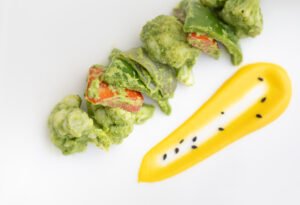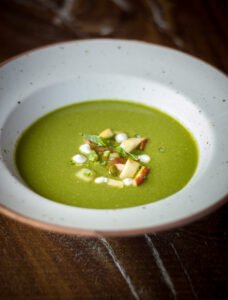MOST UNIQUE CONCEPT OF AYURVEDA : VIRUDHAHARA NEGATIVE FOOD COMBINATIONS
In the world of Ayurvedic healing food and nutrition, there’s a fascinating concept called “Viruddhahara,” which I like to think of as the study of “Negative Food Combinations.”
It’s all about understanding how certain foods, when eaten together, can sometimes create unexpected unhealthy combinations for our body. Viruddhahara explores the complex dance of flavors and textures on our plates and how these combinations can affect our bodies negatively. It’s like a journey into the mysteries of why some food pairs might not be the best choice for our well-being. So, let’s learn how our food choices can either harmonize or disrupt our health.
Viruddhahara Research Study
An interesting study of patients of auto immune conditions and gastric issues revealed the folllowing. Almost all patients were found to have engaged in viruddhahara or negative dietary practices, including excessive consumption of:
- Sharp and spicy foods, Katu Ahara (99.3%)
- Sour and fermented foods, Amla Ahara (95.65%)
- Heavy, cold, stale foods, Guru Ahara (90.57%)
- Oily foods, Snigdha Ahara (86.23%)
- Negative food combinations Viruddha (81.88%)
- Clogging foods like Yoghurt, Abhishyandi Ahara (81.88%)
- Heat producing foods like peppers, hot spices Atiushna Ahara (73.9%)
- Causing excessive thirst like yoghurt, spicey sharp foods, Vidahi (51.44%)
- Ground flour Pistanna (47.10%)
- Day time napping (Diwasvapna – 89.85%)
- Excessive water intake (Antarodaka Paanam – 81.88%)
- Experiencing stress and worry (Chinta – 79.71%)
Viruddhahara, Reheating Oil and Its Connection to Infertility (Santana Dosha): Insights from Charaka Samhita
The ancient Indian text, Charaka Samhita, offers valuable insights into the relationship between dietary practices and overall health. One intriguing aspect discussed in this classic Ayurvedic text is the potential connection between reheating oil and infertility, known as Santana Dosha. While this concept may appear unconventional, it underscores the profound influence that food preparation methods can have on our reproductive health.
1. Quality of Oil Degradation: In Charaka Samhita, the text emphasizes the importance of using fresh, high-quality oils in cooking. Reheating oil, particularly at high temperatures, can lead to its degradation. This degradation process can result in the formation of harmful compounds, such as trans fats and free radicals, which have been associated with various health issues, including hormonal imbalances that can affect fertility.
2. Hormonal Disruption: The quality of oil used in cooking is of paramount importance because it can impact the endocrine system, which regulates hormonal balance in the body. Reheating oil may alter its chemical composition, potentially leading to hormonal disruptions that can affect reproductive health and fertility.
3. Accumulation of Toxins: Ayurveda emphasizes the role of Ama (toxins) in disrupting bodily functions. Reheating oil can contribute to the production of Ama, as it can promote the formation of harmful compounds within the oil. When such toxins accumulate in the body, they can interfere with reproductive processes and overall health.

4. Impact on Digestion: Ayurveda places great importance on efficient digestion for overall well-being. Reheating oil can generate compounds that may challenge the digestive system’s efficiency, potentially leading to poor nutrient absorption and imbalances in the body, including those related to fertility.
5. Ayurvedic Recommendations: Ayurvedic principles often advocate using fresh oils for cooking and avoiding the reheating of oils whenever possible. This aligns with the idea of preserving the oil’s natural qualities and minimizing the formation of detrimental compounds. By adhering to these guidelines, individuals can help maintain their reproductive health and reduce the risk of Santana Dosha.
In essence, Charaka Samhita’s teachings highlight the holistic approach of Ayurveda, where dietary choices and food preparation methods are viewed as integral components of maintaining overall health and fertility. While the connection between reheating oil and infertility may not be immediately apparent, the wisdom passed down through Ayurvedic texts underscores the profound impact of our dietary practices on our well-being, including our reproductive health.
Healing Foods at High Temperatures: The Virudhahara Factor
When it comes to nurturing our bodies with healing foods, we often focus on their nutritional value and health benefits. However, it’s essential to consider the temperature at which we prepare these foods as well. Cooking certain healing ingredients at high temperatures can, in some cases, result in Virudhahara, a term used in Ayurveda to describe incompatible food combinations. While it may seem counterintuitive, here’s why high-temperature cooking methods can sometimes be at odds with the healing properties of specific foods.
1. Nutrient Degradation: Heat is a powerful agent that can break down the delicate structure of vitamins, minerals, and antioxidants found in healing foods. For instance, some vitamins, like vitamin C, are heat-sensitive and can degrade when exposed to high temperatures. This means that the healing potential of such foods may be compromised when they are cooked at high heat for extended periods.
2. Formation of Harmful Compounds: High-temperature cooking methods, such as frying, grilling, or broiling, can also lead to the formation of potentially harmful compounds. For example, the Maillard reaction, which occurs when foods brown during cooking, can produce advanced glycation end-products (AGEs). These compounds have been linked to various chronic diseases and may counteract the healing properties of the foods being prepared.
3. Oxidative Stress: Cooking at high temperatures can promote oxidative stress, a condition characterized by an imbalance between free radicals and antioxidants in the body. Oxidative stress is associated with inflammation and various health issues. Some healing foods, especially those rich in antioxidants, may lose their effectiveness when exposed to oxidative stress during cooking.

4. Alteration of Fats: High-temperature cooking can also impact the fats in healing foods. For instance, essential fatty acids like omega-3s are vulnerable to oxidation when exposed to heat. This can result in the formation of harmful byproducts and reduce the overall health benefits of these fats.
5. Destruction of Enzymes: Healing foods often contain enzymes that play a role in digestion and nutrient absorption. High-temperature cooking can destroy these enzymes, potentially impairing the food’s ability to support digestion and overall health.
Balancing Act: While high-temperature cooking can have adverse effects on certain healing foods, it’s essential to strike a balance. Not all foods are negatively impacted by heat, and some actually become more digestible and nutritious through cooking. The key is to be mindful of the cooking method and temperature for each food item and to choose cooking methods that best preserve their healing properties.
In conclusion, when working with healing foods, it’s important to consider the impact of high-temperature cooking on their nutritional value and health benefits. While heat can have both positive and negative effects, being aware of these factors allows us to make informed choices that align with our health and well-being goals.
Understanding Negative Viruddhahara Food Combinations for Well-Being
So, let’s talk about food incompatibilities, or as they say in Ayurveda, Viruddha-Aahara. It’s all about understanding what goes well together and what doesn’t in terms of food and its various aspects.
First up, we’ve got Desha Viruddha, which is all about the place. It means that the climate or environment can affect what you should eat. For example, you might want to avoid hot and spicy stuff in a scorching summer and opt for cooler foods.
Next, we have Kala Viruddha, which considers the timing of your meals. Eating pungent foods in the heat of summer or icy treats in the dead of winter might not be the best idea.
Then comes Agni Viruddha, which deals with your digestive fire. Some foods can either stoke or smother your digestive flame. So, it’s essential to know what your body can handle.
Matra Viruddha is all about quantity. Sometimes, even healthy stuff can turn bad if you overdo it. Take honey and cow’s ghee, for instance; mixing them equally may not be a great idea in large quantities.
Satmya Viruddha is about sticking to what your body is used to. Sudden changes in your diet can throw your system off balance.
Dosha Viruddha takes into account your body’s constitution. Foods that aggravate your specific dosha (Vata, Pitta, or Kapha) should be avoided.
Sanskar Viruddha considers the mode of preparation. Heating honey, for instance, can change its properties and make it not so good for you.
Veerya Viruddha looks at the potency of foods. Combining fish and milk, for example, might not be the wisest choice.
Koshtha Viruddha is all about your digestive tract. Some foods might be harsh on your stomach and intestines.
Avastha Viruddha factors in your health condition. Eating certain foods when you’re unwell might hinder your recovery.
Krama Viruddha considers the sequence of eating. Having curd at night or switching between sweet and spicy during a meal can be tricky.
Parihara Viruddha is about contraindications. Like having ice-cold water right after a piping hot cup of tea; not the best idea.
Upachara Viruddha involves treatments and therapies. Certain foods might interfere with your healing process.
Paaka Viruddha deals with cooking methods. Knowing how to cook foods properly can make a world of difference in their compatibility.

Samyoga Viruddha looks at food combinations. Ever heard that milk and bananas shouldn’t go together? That’s an example.
Hriday Viruddha concerns your heart, not just metaphorically. Some foods can put a strain on your cardiovascular system.
Sampad Viruddha relates to the quality of food. Rich, heavy foods at the wrong time can lead to issues.
Vidhi Viruddha is about following the rules. Ayurveda has its guidelines for how to eat food properly, and not following them can cause problems.
So, there you have it, a breakdown of food incompatibilities or Viruddha-Aahara in a nutshell. It’s all about understanding what works best for your body and keeping things in harmony.
Category 1: Milk Incompatibilities
- Milk along with fish is especially Ama Visha causing.
- All sour things mixed with milk become incompatible.
- Milk with lentils like horse gram and black gram.
- Milk should not be had immediately after eating leafy vegetables; this leads to skin disease.
- Milk and salt should not be mixed.
- Milk is not compatible with fruits, melons, sour fruits, and bananas. It should not be consumed with salty items such as samosa/paratha/khichadi. Don’t boil it with tea.
Category 2: Yogurt Incompatibilities
- Meat of chicken and venison should not be cooked along with yogurt.
- Yogurt is to be avoided with cheese, hot drinks, sour fruits, milk, mangoes, nightshades, beans, eggs, fish.
- Cheese cannot be paired with eggs, fruits, hot drinks, milk, beans, yogurt.
Category 3: Other Food Incompatibilities
- Soup of black gram and radish.
- Green leafy vegetables cooked with butter.
- Fruits of acidic nature eaten along with yogurt, soup of black gram, jaggery, honey, or ghee.
- Banana combined with yogurt, milk, and buttermilk.
- Ghee which has been kept for more than ten days in a bronze vessel.
- Heating wines, yogurt, and honey causes dangerous Ama Visha build-up.
- Honey, ghee, animal fat, sesame oil, and water mixed in equal quantities, in the combination of two, three or all of them are incompatible and even lead to death.
- Haridraka, raw turmeric, cooked in mustard oil is incompatible and causes a profound increase in Pitta.
- Indian milk and rice pudding, kheer, followed by floury and sugary desserts are incompatible and cause a profound increase in Kapha.
- Grains should not be consumed with Tapioca and Fruits.
- One should not consume fruits and milk with vegetables.
- Beans are the wrong combination with eggs, milk, fish, fruits, yogurt, and meat.
- Fat and proteins are mismatched foods as they need different digestive juices.
- Proteins are not compatible with starches, and their collective consumption may result in delayed digestion.
- Nightshades (tomato, potato, etc.) are not compatible with fruits like cucumber, melon, and dairy products.
- Milk, yogurt, tomatoes, and cucumber are incompatible with lemons.
Some Complications from Viruddhahara According to Ayurveda
- Impotency: Impotency refers to the inability to achieve or maintain an erection, which can affect a person’s ability to engage in sexual activity. It’s essential to seek medical advice and support for this condition, as there can be various underlying causes.
- Visarpa (Erysipelas): Visarpa, also known as erysipelas, is a bacterial skin infection characterized by red, swollen, and painful skin. It’s crucial to treat this condition promptly with antibiotics to prevent its spread.
- Blindness: Blindness is the complete loss of vision in one or both eyes. It can result from various causes, including eye diseases, injuries, or underlying medical conditions. Early detection and treatment are essential to manage or prevent vision loss.
- Ascites: Ascites is the accumulation of fluid in the abdominal cavity, often due to liver disease or other medical conditions. It can lead to abdominal discomfort and requires medical evaluation and management.
- Bullous: Bullous conditions involve the formation of blisters on the skin or mucous membranes. These can be caused by autoimmune diseases, infections, or genetic factors, and proper diagnosis and treatment are crucial.
- Insanity: Insanity refers to severe mental illness, often affecting one’s thoughts, behaviors, and ability to function in daily life. Compassionate mental health care is essential for individuals facing this condition.
- Fistula in Ano: A fistula in ano is an abnormal tunnel-like passage that forms between the rectum or anal canal and the skin near the anus. It typically requires surgical intervention for proper treatment.
- Coma or Fainting: Coma is a deep and prolonged state of unconsciousness, while fainting (syncope) is a temporary loss of consciousness. Both conditions require immediate medical attention to determine the underlying cause and provide appropriate care.
- Intoxication: Intoxication refers to the state of being under the influence of alcohol, drugs, or other substances. It can impair judgment and physical abilities, leading to accidents or health risks. Seek help for substance abuse issues.
- Abdominal Distention: Abdominal distention is the abnormal swelling or enlargement of the abdomen. It can result from various gastrointestinal issues and should be evaluated by a healthcare professional.
- Stiffness in Neck: Neck stiffness can occur due to muscle tension, injury, or underlying medical conditions. It may limit neck mobility and can be managed through physical therapy or medical treatment.
- Varieties of Anemia: Anemia is a condition characterized by a deficiency in red blood cells or hemoglobin, leading to fatigue and weakness. There are different types of anemia, each with its specific causes and treatments.
- Indigestions: Indigestion, also known as dyspepsia, causes discomfort or pain in the upper abdomen. It can result from overeating, dietary choices, or underlying gastrointestinal conditions.
- Various Skin Diseases: Skin diseases encompass a wide range of conditions affecting the skin’s appearance and function. These can include acne, eczema, psoriasis, and dermatitis, each requiring specific treatments and care.
- Diseases of Intestines: Diseases of the intestines can involve conditions such as irritable bowel syndrome (IBS), inflammatory bowel disease (IBD), or infections. Proper diagnosis and treatment are essential for managing these conditions.
- Swelling: Swelling, also known as edema, can occur in various parts of the body and may be a sign of an underlying issue. It’s essential to identify the cause and manage it accordingly.
- Gastritis: Gastritis is inflammation of the stomach lining, often causing abdominal discomfort and indigestion. It can be triggered by various factors, including diet and stress, and requires appropriate treatment.
- Fever: Fever is a common symptom of an underlying infection or illness. It’s the body’s natural response to fight off pathogens. Monitoring and managing fever are essential for recovery.
- Rhinitis: Rhinitis is inflammation of the nasal mucous membranes, leading to symptoms like a runny or stuffy nose. It can be caused by allergies, infections, or irritants and can usually be managed with appropriate measures.
- Infertility: Infertility refers to the inability to conceive or carry a pregnancy to term. It can result from various factors in both men and women and often requires specialized medical evaluation and treatment options.
If Food is Medicine then Viruddhahara is Disease, A Final Word

In our journey through life, taking care of our health is a deeply nurturing act as “Food is Medicine”. One significant aspect of this care is understanding how different foods interact with each other and how these interactions can impact our well-being. Let’s explore a few more negative food combinations, guided by the wisdom of Ayurveda and modern science.
Tea and Milk: A Heart-Healthy Connection
Picture this: a comforting cup of tea, steam gently rising, and a splash of milk to make it just perfect. Tea, whether it’s the calming green or the robust black variety, contains heart-friendly compounds called catechins. These little wonders do wonders for your heart health. However, when milk joins the party, something intriguing happens. The proteins in milk, called caseins, interact with those precious catechins, causing their concentration to dip. To maximize the heart-loving benefits of your tea, consider savoring it without milk. Your heart will thank you with every sip.
Milk and Yoghurt: A Delicate Harmony
Milk and yoghurt, both delightful dairy delights on their own, can sometimes engage in a not-so-harmonious dance when consumed together. The result? Curdling in your stomach, which might lead to discomfort and even a bout of nausea. To ensure a smoother digestive experience, it’s wise to enjoy these dairy delights separately. Your tummy will appreciate the kindness.
Tea and Garlic: A Cautionary Tale
Tea and garlic each have their own unique benefits. Tea brings anticoagulant compounds called coumarins to the table, while garlic boasts its own anticlotting properties. But when these two health heroes team up in your system, they may increase the risk of bleeding. For a safer path, consider savoring tea and garlic individually.
Pomegranate Juice and Grapefruit Juice: Medication Matters
Pomegranate and grapefruit juices are both treasure troves of health perks. However, they share a special trait—they can influence an enzyme system in your intestines known as cytochrome P450 3A4. This can impact the way your body processes certain medications. Mixing these two juices together might enhance this interaction, potentially affecting your medication levels. To nurture your health, consider enjoying these juices separately.
Unripe Tomatoes or Potatoes and Alcohol: A Relaxing Consideration
Imagine a delightful evening with a glass of wine and a plate of delicious food. But be mindful when it comes to unripe green tomatoes. They contain solanine, which can interact with alcohol, possibly intensifying its sedative effect. To ensure a more comfortable relaxation, opt for ripe tomatoes or potatoes instead when enjoying your libations.
Cooking with Care: The Sanskara Viruddha
When it comes to cooking, the methods we choose matter for our health. Deep frying potatoes, for instance, can produce acrylamide, a compound that has been linked to potential carcinogenic effects. As for honey, the honey you find in stores, often labeled as Agmark honey, undergoes significant heating before packaging. In Ayurveda, it’s advised not to heat honey for specific reasons. To nurture your health, consider alternative cooking techniques for your potatoes and appreciate honey in its natural form.
In our journey to nurture our health, understanding food combinations is like tending to a beautiful garden. Each choice we make has the potential to promote wellness and harmony within our bodies. With these warm and nurturing insights, may your culinary adventures be filled with both pleasure and good health.
Remember, your well-being is a cherished treasure, and these gentle tips are here to support you on your path to health and happiness. Stay well-nurtured!





The breadth of knowledge compiled on this website is astounding. Every article is a well-crafted masterpiece brimming with insights. I’m grateful to have discovered such a rich educational resource. You’ve gained a lifelong fan!
Hey people!!!!!
Good mood and good luck to everyone!!!!!
Wow, fantastic weblog layout! How long have you ever been blogging for? you made running a blog glance easy. The entire look of your website is great, let alone the content!